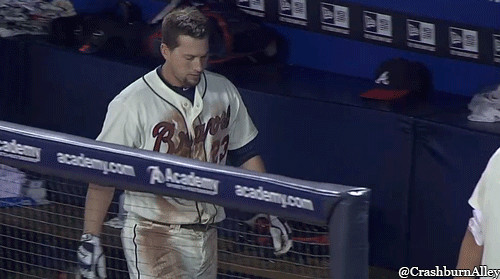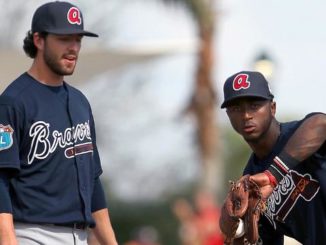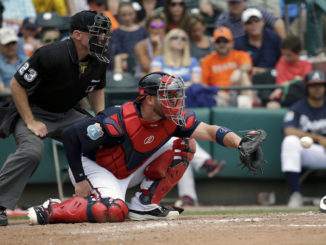There’s a lot of debate going on right now among Braves fans about the decision to option Christian Bethancourt to AAA and bring up Ryan Lavarnway. On the surface, one would immediately think… why is there debate about this? Bethancourt has a wRC+ of 40, swings at 48% of pitches outside the strike zone, and wasn’t getting regular playing time. A.J. Pierzynski‘s 102 wRC+ earned him a starting spot, and Bethancourt could use regular playing time. Even though Bethancourt would probably be better going forward, ZiPs projects him for 78 wRC+ going forward. That’s still more than 20% worse than a league average hitter. The same trusted projection system projects Lavarnway at 86 wRC+. Beth should be playing more regularly than Lavarnway, due to his upside, and Lavarnway is likely the better MLB hitter right now. It seems like a pretty easy decision.

But there’s complexity here, not so much with Lavarnway’s corner of the triangle, but with the decision to play Pierzynski over Bethancourt. To begin with, since April, when AJ was on fire and Bethancourt was awful, Bethancourt has outhit Pierzysnki. Since May 1:
Bethancourt: .250/.262/.359 (.294 BABIP)
Pierzynski: .216/.259/.294 (.244 BABIP)
Some of that is BABIP-driven, so perhaps Pierzynski’s might still be the line to go forward with, but we could at least come to the conclusion that they’re much closer to one another offensively than the wRC+ gulf suggests. Bethancourt has been an improved hitter lately.
Another point being made is a point I want to examine more closely, and that’s that Bethancourt’s defense is leaps and bounds better than Pierzynski’s. CB certainly dominates in the quick reference catcher value stats, with a significant edge in Fangraphs’ DEF (+3.0 to -0.2) and B-R’s dWAR (+0.6 to -0.5). Bethancourt has seemingly done a better job not just throwing out baserunners but discouraging them altogether: runners are 30/36 against Pierzynski and just 10/16 against Bethancourt.
Before going further, I’ll point you to some Beyond the Box Score research from 2013 that revealed something I’d suspected for a long time: pitchers are more responsible for steal success and attempt rates than the catcher. Really, it’s the combined battery that most effects things, but pitchers individually have more of an effect than catchers. Click on the link and read. It’s really great stuff, and the results seem pretty conclusive. Don’t worry, I’ll still be here when you’re done. Done? Ok, great.
I decided to see if this could have affected the SB numbers for the Braves. I looked at 8 pitchers who had both significant MLB experience prior to this season and at least 20 innings pitched this season:
| Pitcher/Batter | Innings | SB/Attempts | SB Success % | SB Success +/- | SB/IP | SB Attempt +/- |
|---|---|---|---|---|---|---|
| Teheran/Career | 508 | 27/36 | 75.0 | n/a | .071 | n/a |
| Teheran/Bethancourt | 60.1 | 2/5 | 40.0 | -35.0 | .083 | +.012 |
| Teheran/Pierzysnki | 15.0 | 1/1 | 100.0 | +25.0 | .067 | -.004 |
| Grilli/Career | 575.1 | 23/33 | 69.7 | n/a | .057 | n/a |
| Grilli/Bethancourt | 10.0 | 0/0 | n/a | n/a | .000 | -.057 |
| Grilli/Pierzysnki | 13.1 | 0/0 | n/a | n/a | .000 | -.057 |
| Avilan/Career | 169.2 | 10/13 | 76.9 | n/a | .077 | n/a |
| Avilan/Bethancourt | 9.1 | 1/1 | 100.0 | +23.1 | .107 | +.030 |
| Avilan/Pierzysnki | 16.0 | 1/1 | 100.0 | +23.1 | .063 | -.014 |
| Stults/Career | 683.1 | 38/52 | 73.1 | n/a | .076 | n/a |
| Stults/Bethancourt | 22.1 | 0/2 | 0 | -73.1 | .090 | +.014 |
| Stults/Pierzysnki | 25.1 | 1/1 | 100.0 | +26.9 | .039 | -.037 |
| Johnson/Career | 483.2 | 34/43 | 79.1 | n/a | .089 | n/a |
| Johnson/Bethancourt | 10.1 | 3/3 | 100.0 | +20.9 | .290 | +.201 |
| Johnson/Pierzysnki | 20.0 | 3/3 | 100.0 | +20.9 | .150 | +.061 |
| Miller/Career | 454.2 | 29/41 | 70.7 | n/a | .090 | n/a |
| Miller/Bethancourt | 18.0 | 1/1 | 100.0 | +29.3 | .056 | -.034 |
| Miller/Pierzynski | 66.2 | 5/7 | 71.4 | +0.7 | .105 | +.015 |
| Wood/Career | 322.2 | 14/23 | 60.9 | n/a | .071 | n/a |
| Wood/Bethancourt | 11.2 | 0/0 | n/a | n/a | 0 | -.071 |
| Wood/Pierzynski | 61.2 | 4/6 | 66.7 | +5.8 | .097 | +.026 |
| Cahill/Career | 1066.2 | 110/146 | 75.3 | n/a | .137 | n/a |
| Cahill/Bethancourt | 14.2 | 2/3 | 66.7 | -8.6 | .205 | +.068 |
| Cahill/Pierzynski | 11.2 | 3/3 | 100.0 | +24.7 | .257 | +.120 |
| ALL/Career | 4264 | 285/ 387 | 73.6 | n/a | .091 | n/a |
| ALL/Bethancourt | 156.2 | 9/15 | 60.0 | -13.6 | .096 | +.005 |
| ALL/Pierzynski | 229.2 | 18/22 | 81.8 | +8.2 | .096 | +.005 |
As you can see, Bethancourt does have a better arm, but we knew this. Pierzysnki is a little below average at throwing out runners. But this does a good job illustrating that Bethancourt doesn’t really scare potential base stealers any more than Pierzynski. There’s a notion that the threat of his arm holds runners, but the stats for Bethancourt just aren’t there.
The table tells us that yes, Bethancourt is better than Pierzysnki, but perhaps it’s not by the amount that the raw steal rates would have led us to believe. But you might notice this accounts for 22 of the 36 attempts against Pierzysnki. Where are the rest? 8 attempts have come when Pierzynski caught Mike Foltynewicz. Pierzynski has caught only a few more innings (31 to 21) for Foltynewicz, but they’ve been far more effective innings. I’m not ascribing Folty’s success to having Pierzynski behind the plate, but that success can affect the opposing team’s strategy. With AJ catching, opponents have a .305 OBP and .362 SLG against Folty, and 8 SB attempts. With CB catching, it’s .426 and .638. When you’re hitting doubles and homers, you don’t really need the SB as much. Again, I’m not sure how much, if at all, I believe in catcher ERA and that sort of thing, so I’m not crediting Pierzynski for limiting the doubles & homers. I’m just noting that the lack of doubles and homers creates a tougher situation for AJ, at least in terms of limiting steals and steal attempts. Both have surrendered steals with David Aardsma on the mound, and AJ has been behind the plate for guys like Juan Jaime, Sugar Ray Marimon, Cody Martin, Nick Masset, and Williams Perez.
Still, I don’t want this to sound too strongly like a out and out defense of AJ Pierzynski’s defense. Using linear weights of SBs (+.22) and CS (-.45), when a baserunner attempts to steal on Christian Bethancourt, it has an expected run value of -.05 runs. When one runs on AJ, it has an expected run value of +.10 runs. That’s a difference of .15 runs per attempt. They yield attempts at roughly the same rate (+.005 per inning over expected). Going off the numbers in the table, the Braves gain around .13 runs per game having Bethancourt in the starting lineup. Over 100 games, that’d be worth around 1.4 wins. It’s a nice difference. But it’s not a huge difference, and not a bigger difference than what bats can do.
There’s also more to catching than limiting steal attempts and throwing out baserunners. There’s framing, for example. According to StatCorner.com, Pierzynski has been worth -3.2 RAA in framing pitches, while Bethancourt is at -4.4. On a per-inning basis, that’s -.0097 for AJ and -.0186 for Bethancourt. Roughly every 100 innings they catch, Pierzynski is worth an extra run in pitch framing. Over 100 games (the same sample that yielded a 1.4 win advantage for Bethancourt), Pierzynski would be worth a win more than Bethancourt in framing. Baseball Prospectus’ framing stats agree that Bethancourt is an inferior pitch framer to Pierzynski.
All things considered, I’m not sure Bethancourt is a better overall defensive option than Pierzynski going forward. I think he probably is, exclusively based on talent and age, but I’m not sure about it. When runners take off, Beth is better. On borderline pitches, AJ is better. Pierzynski seems to have handled pitchers a little better, but it’s not by a huge margin (.721 OPS to .764). I think it’s fine to prefer either, but I just don’t see one as definitively better than the other when it comes to preventing runs.
So the debate re-centers on the big picture. Is it better to try to contend while in contention, putting the better hitter (Pierzynski, according to 2015 results, ZiPs projections, and anything other than a small sample of 5 weeks) out there, or should the Braves focus on long-term development and let Bethancourt learn his way in the big leagues? I don’t think this team is a true contender, but there is some value in young players at least believing they’re in the mix. It’s better for them to experience some winning and fall out of the race around August or so than it is for the team to just pack it in while just 3 or 4 games back. Mediocre teams have made the playoffs before, and hope is a more powerful agent in the player development process than some believe.
I’ve stayed away from Bethancourt’s attitude. I don’t know much about it, and there are various things floating around. If it’s a problem, AAA is where he can work it out. I don’t know that it is, but the Braves’ decision makes even more sense if that’s the case.
The Braves are going with AJ for now. He’s on a 1 year deal, so if he still resembles a useful veteran a month from now and the team is falling out of the race, he could be dealt to a contender. Bethancourt will be back at some point, likely to finish the year as the starter. But for now, I’m not sure the Braves really had a wrong answer as to who’d start regularly. There’s benefit to both, and I can’t really see a case for one being much stronger than the other. They chose AJ. With that choice made, Lavarnway makes much more sense as a backup, and hopefully Bethancourt, who still hasn’t had even 400 plate appearances in AAA, can continue to improve his game playing every day in Gwinnett.




Leave a Reply